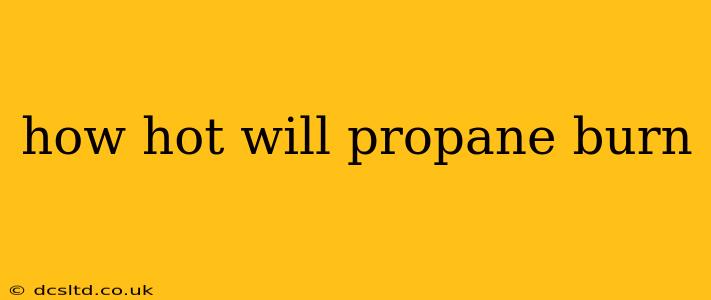Propane, a widely used fuel for heating, cooking, and other applications, burns incredibly hot. But the exact temperature isn't a single number; it varies depending on several factors. This article will delve into the specifics, answering common questions and providing a comprehensive understanding of propane combustion temperatures.
What is the typical burning temperature of propane?
The theoretical adiabatic flame temperature of propane in air is approximately 3,600°F (1,982°C). This is the maximum temperature achievable under ideal, perfectly efficient combustion conditions where no heat is lost to the surroundings. However, real-world scenarios are far from ideal.
What factors affect the actual burning temperature of propane?
Several factors influence the actual temperature achieved when propane burns:
-
Air-to-fuel ratio: A perfectly stoichiometric mixture (the ideal ratio of propane and air for complete combustion) yields the highest temperature. Too much air (lean mixture) or too little air (rich mixture) will lower the temperature. A lean mixture results in incomplete combustion and lower temperatures, while a rich mixture produces soot and also lower temperatures.
-
Pressure: Higher pressure generally leads to higher temperatures, as it increases the density of the reactants, promoting more efficient combustion.
-
Ambient temperature: The surrounding temperature influences the heat loss from the flame, affecting the final temperature. A colder environment will result in slightly less heat loss and thus a marginally higher flame temperature.
-
Type of burner: Different burner designs impact mixing efficiency and heat transfer. A well-designed burner will achieve higher temperatures by maximizing the mixing of propane and air.
-
Presence of other gases: If other gases are present in the combustion process, they can influence the reaction and the resulting temperature.
How hot does a propane grill get?
Propane grills typically reach temperatures between 500°F and 700°F (260°C and 371°C). This is significantly lower than the theoretical adiabatic flame temperature due to heat loss to the surrounding environment and the design of the grill itself. Factors like burner design, air vents, and the type of cookware used also play a role.
How hot does a propane torch get?
Propane torches can achieve much higher temperatures than grills, reaching 2,000°F (1,093°C) or more. This is because they are designed for concentrated heat, and the flame is typically much smaller and more focused.
What are the safety considerations when working with propane?
Propane is a flammable gas, and safety is paramount when handling it. Always follow these guidelines:
-
Proper ventilation: Ensure adequate ventilation to prevent the buildup of propane gas, which can lead to explosions or asphyxiation.
-
Leak detection: Regularly check for leaks using soapy water. Bubbles indicate a leak.
-
Storage: Store propane cylinders upright in a well-ventilated area away from ignition sources.
-
Professional installation: Have propane appliances installed and serviced by qualified professionals.
What are the uses of propane besides grilling and torches?
Propane's versatility extends beyond grills and torches. It's commonly used for:
- Heating: Home heating systems, water heaters, and space heaters.
- Cooking: Stoves and ovens.
- Industrial applications: Welding, cutting, and drying.
- Motor vehicles: Autogas, a cleaner alternative to gasoline.
Understanding the factors affecting propane's burning temperature helps us appreciate its diverse applications and use it safely and efficiently. While the theoretical maximum is impressive, the practical temperature achieved depends on the specific conditions and application. Always prioritize safety when working with propane.
